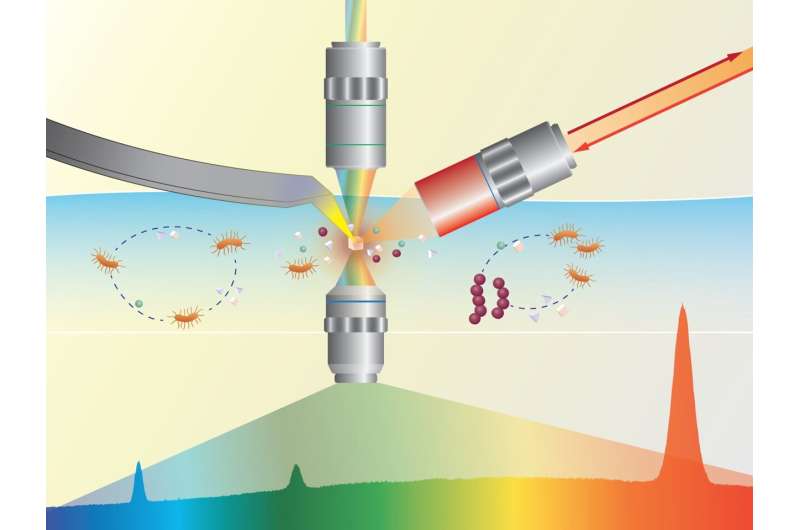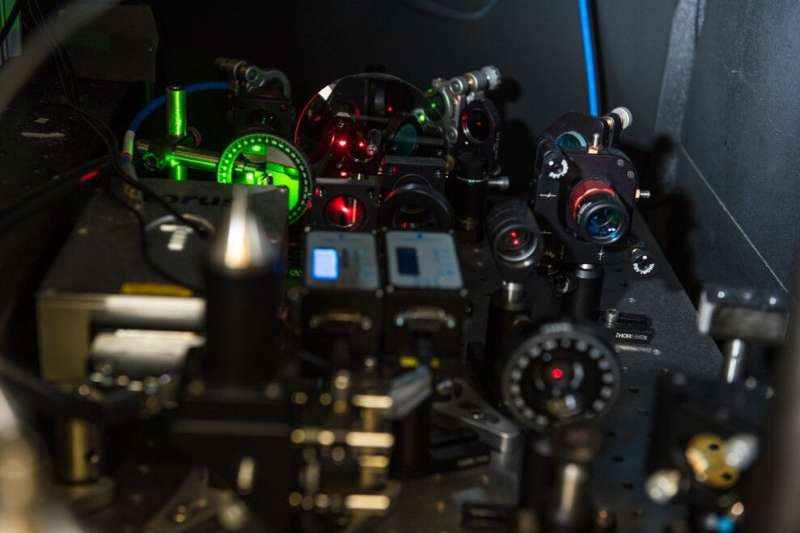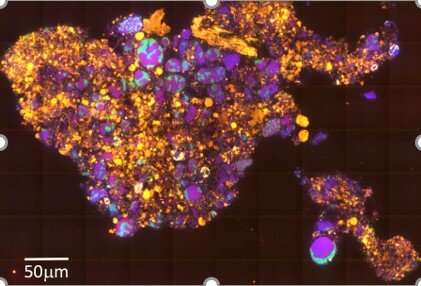
Microbes may be among the smallest living things on Earth, but bioimaging to understand the chemistry that fuels these organisms could reveal important clues about the intricacies of gene function and the health of the planet. Because of this, scientists have long sought ways to eavesdrop on conversations between living microbes in their environment.
This has been exceptionally difficult, in part because microbes communicate using molecules instead of words. Deciphering conversations means identifying small, specific, and quickly changing molecules called metabolites, something even the most powerful instruments struggle to attempt. But a team of researchers at Pacific Northwest National Laboratory (PNNL) have spent the last decade continuously developing a next-generation bioimaging instrument that is making progress toward this goal.
The Chemical Dynamics Initiative (CDi), an internal PNNL investment, supported PNNL chemist Patrick El Khoury and his team as they developed the technology to measure phenomena in the quantum realm. Here the team imaged subatomic waves of energy called phonons as they formed, beat, and dissipated in a single trillionth of a second.
“Similar technologies can be used to image phonons and metabolites in real space and real time,” said El Khoury. “The fundamental advances required in both areas comprise a challenge worthy of a national laboratory and continued investments.”
Now researchers are taking the technologies to the next level as they use bioimaging to map metabolites exchanged by live microbes.
Bioimaging to fish out whispers in a crowd
The bioimager is known as BIGTUNA, short for BioImaginG Technology Using Nano-optical Approach. The keys to BIGTUNA are its multiple optical capabilities, each providing complementary information about the position and composition of molecules in a study sample. Many laser sources focus on the tip of a very sharp nanosized needle. Researchers position the needle’s tip in the sample area they want to examine, then use the light focused on the tip of the needle to measure the sample’s physical and chemical features. Through this, researchers identify molecules and understand how they interact.

Chemical bioimaging with light has been done for a hundred years, but never at this molecular scale.
“Some methods illuminate a relatively large area, but these far-field approaches are like listening in to a crowd and expecting to understand individual conversations,” said PNNL chemist Scott Lea. To overcome this challenge, researchers focused on combining a wide range of near-field techniques to capture and characterize the maximum information in an area as small as a few molecules.
“If we don’t have multiple streams of data coming from multiple techniques, we only get partial information,” said El Khoury. “And in addition to developing the techniques, we developed our understanding of optical selection rules to maximize the information we get from one sample in one set-up.”
In the most recent iteration of this project, the researchers zoomed out to a larger area, although still only a thousandth the thickness of a strand of hair. At this slightly farther distance, they identified the most promising approaches to capture information about the patterns of molecular bonds and the distribution of electrons. These new nano-optical measurements are addressing a much smaller number of molecules; therefore, the researchers must continue developing new theories that describe nanoscopic interactions of light and matter.
Combining these conceptual and technological developments will allow the researchers to move beyond model systems they studied using early incarnations of BIGTUNA. The chemical signals in these model systems were much stronger than chemical signals from the metabolites involved in microbial communications. In addition to having weaker signals, biological samples are also susceptible to damage by light, which is why BIGTUNA’s noninvasive approach makes it ideal to develop for bioimaging applications. Including state-of-the art data and computational techniques from PNNL data scientists Sarah Akers and Edo Aprà will help automate where and how the instrument balances exploration with the sensitivity of a living system.
Bioimaging to tune in to talking microbes
As an initial foray into biology, researchers are focusing BIGTUNA’s bioimaging power on a community of symbiotic microbes that live in deep ocean sediments. One microbe reduces sulfur, the other oxidizes methane, a powerful greenhouse gas.

Previous approaches to unraveling microbial interactions have mainly focused on identifying influential genes or on examining isolated enzymes and pathways. The approaches often include fixing, freezing, or combining the biological system. But these approaches lose out on time-dependent or space-specific details. And the researchers can’t look at the flow of metabolites to get a predictive understanding of how and why microbes interact.
Even so, PNNL collaborator and CalTech geologist Victoria Orphan has theories about how these symbiotic microbes share metabolites. Bioimaging with BIGTUNA could produce the first close-up view of the metabolites in action as the instrument sends light through the sample and measures what gets absorbed or scattered. Researchers use the information to identify metabolites and create a detailed record of microbial intercellular communication pathways. In turn, this knowledge could help researchers understand the degree to which microbes respond to environmental changes.
A new generation of nano-optics
“Possibilities for BIGTUNA extend far beyond the realm of bioimaging,” said Peter Sushko, CDi’s chief scientist. “Because this highly adaptable instrument can obtain detailed information describing atomic motion and electronic processes, it will be useful in seeking answers to a broad range of questions that are of interest to chemists, physicists, and materials scientists as well.”
Potential applications include quantum materials, catalysis, and human health, in addition to the current work in microbial systems. In that realm, planned future developments could incorporate environmental controls to further generalize the approach.
A portion of the blueprint for BIGTUNA was designed under PNNL’s CDi, a five-year internal investment in capabilities to better understand and predict the evolution of complex chemical systems in real-world or operational environments.
Provided by Pacific Northwest National Laboratory

